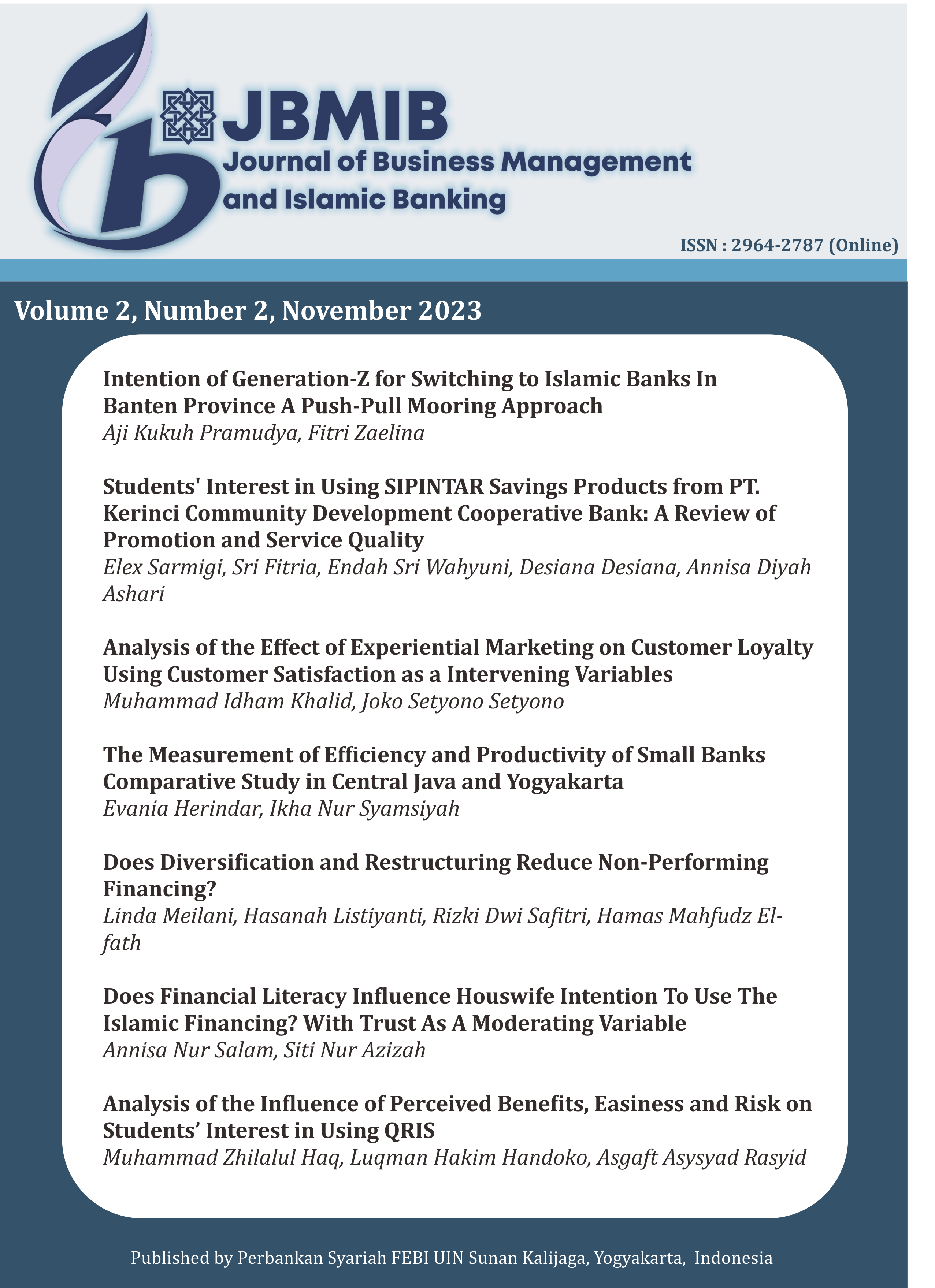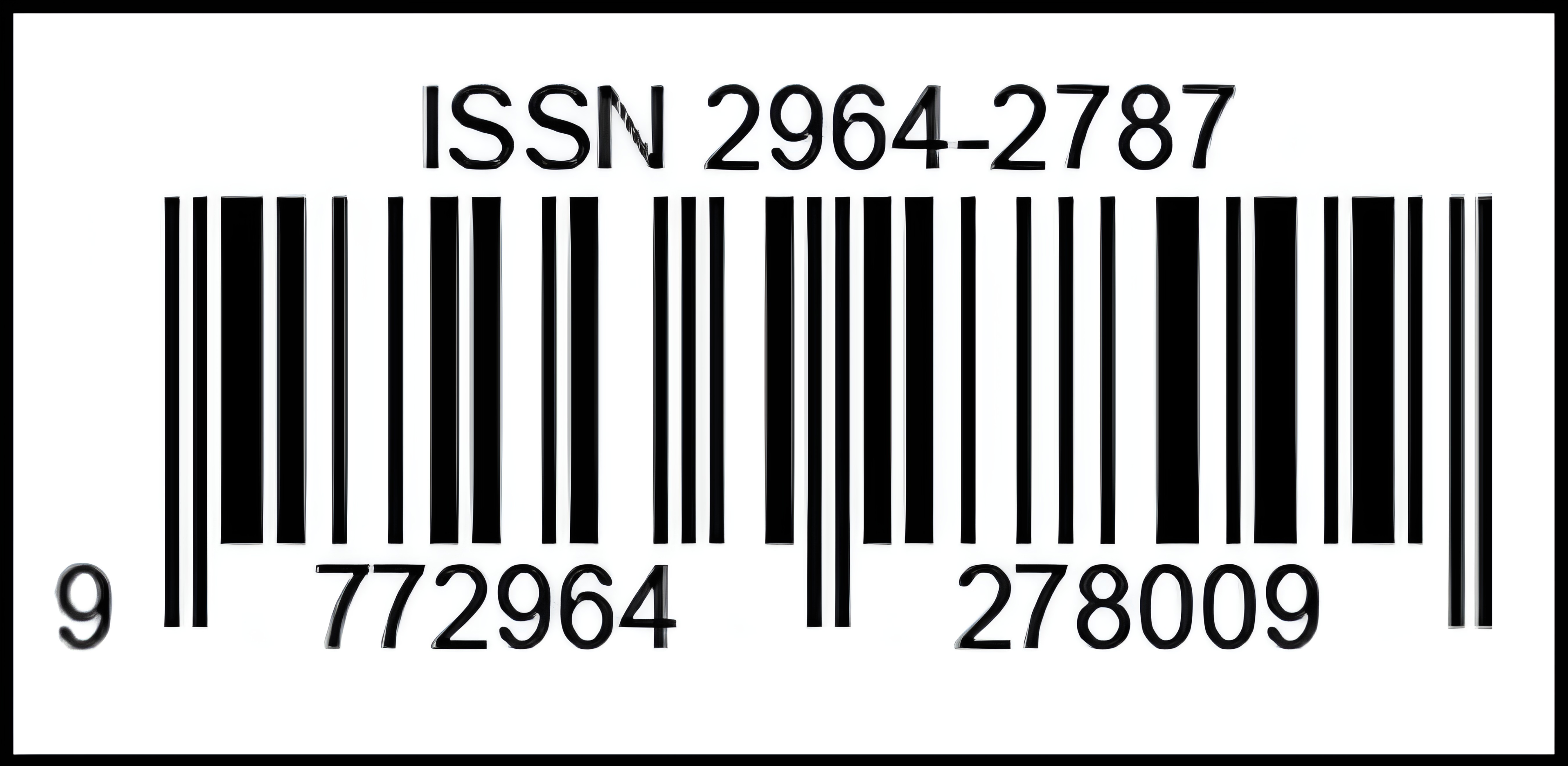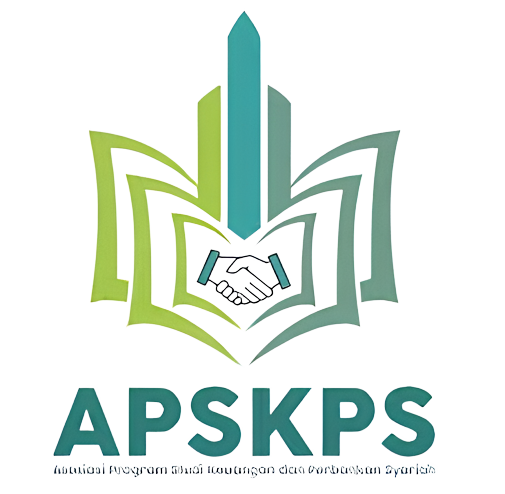Does Financial Literacy Influence Houswife Intention To Use The Islamic Financing? With Trust As A Moderating Variable
DOI:
https://doi.org/10.14421/jbmib.v2i2.2069Keywords:
Housewife, Islamic Financing, Financial Literacy, PLS-SEM, TrustAbstract
Research Aims: This study aims to analyze the effect financial literacy on the houswife intention to use islamic financing with trust as a moderating variable.
Methodology: This study involved 358 housewife respondent in 32 Indonesian provinces. The model used was based on the theory of reasoned action development with the partial least squares structural equation modeling as the data processing tool.
Research Findings : Housewives' financial literacy influences mothers' intentions to use Islamic bank financing products.
Originality: Although numerous studies have concentrated on financial literacy and the use of sharia financing, the behaviour of houswife and the high number of housewife loans to informal institutions concern academics and practitioners. This research can highlight the importance of financial literacy for housewives can avoid applying for loans to informal institutions, so sharia financing can be a suitable alternative.
Research limitation and implication: The study discovered that financial literacy with variabel ability, attitude and knowledge affect the intention of houswife to use the Islamic financing. Meanwhile, the trust variable failed to moderate the housewife's ability to use Islamic financing. The trust variable was not successful in moderating the attitude and knowledge of the housewife to use Islamic financing. Meanwhile the trust variable significantly moderates the attitude towards the financing variable with a significance
Downloads
 Abstract viewed: 278 times
|
Abstract viewed: 278 times
|
 PDF downloaded = 333 times
PDF downloaded = 333 times
References
Ahmad, Z. A., & Rusdianto. (2020). Impact of Transparency and Accountability on Trust and Intention to Donate Cash Waqf in Islamic Microfinance Institutions. Shirkah: Journal of Economics and Business, 5(2).
Albaity, M., & Rahman, M. (2019). The intention to use Islamic banking: an exploratory study to measure Islamic financial literacy. International Journal of Emerging Markets, 14(5), 988–1012. https://doi.org/10.1108/IJOEM-05-2018-0218
Angela A. Hung, Andrew M. Parker, J. K. Y. (2009). Defining and Measuring Financial Literacy (No. W.R. 708). Final Report to ASHRAE. https://doi.org/10.2139/ssrn.1498674
Antonia Grohmann, R. K. and L. M. A. (2014). Roots of Financial Literacy Antonia. In Roots of Financial Literacy Beiträge (pp. 1–30).
Ashraf, M. G. (2015). Include the Position of Islamic Banking , Service Quality , Satisfaction , Trust and Loyalty in the Context of an Integrated Model for Islamic Finance. European Journal of Business and Management, 6(17), 156–170. www.iiste.org
Bananuka, J., Mukyala, V., Tumwebaze, Z., & Kasera, M. (2020). The intention to adopt Islamic financing in emerging economies : evidence from Uganda. Journal of Islamic Accounting and Business Research, 11(3), 610–628. https://doi.org/10.1108/JIABR-07-2017-0108
Bernado, A. B. I. (2000). On Defining and Developing Literacy across Communities. International Review of Education, 46(455–465).
C.J., M., Rooij, V., Lusardi, A., & Alessie, R. J. M. (2012). Financial Literacy, Retirement Planning And Household Wealth. The Economic Journal, 122(560), 449–478. https://doi.org/10.1111/j.1468-0297.2012.0251.x.
Calamato, M. P. (2010). Learning Financial Literacy in the Family. Master’s Theses, 1(December), 1–19. https://doi.org/10.1017/CBO9781107415324.004
Canavari, M., Castellini, A., & Spadoni, R. (2010). Challenges in Marketing Quality Food Products. Journal of International Food & Agribusiness Marketing, 22, 203–209. https://doi.org/10.1080/08974431003641141
Corcoran-nantes, Y. (2016). Muslim Women Financial Institutions. https://doi.org/10.1093/acref
Crossan, D., Feslier, D., & Hurnard, R. (2011). Financial literacy and retirement planning in New Zealand. Journal of Pension Economics and Finance, 10(4), 619–635. https://doi.org/10.1017/S1474747211000515.
Creswell, J.W. (2007), Qualitative Inquiry and Research Design Choosing among Five Approaches, 3rd
ed., Sage, London.
Creswell, J.W. and Plano Clark, V.L. (2010), Designing and Conducting Mixed Methods Research,
(2nd Ed.), Sage, Thousand Oaks, CA.
DeKinder, J.S. and Kohli, A.K. (2008), “Flow signals: How patterns over time affect the acceptance of
start-up firms”, Journal of Marketing, Vol. 72 No. 5, pp. 84-97, doi: 10.1509/jmkg.72.5.084.
Díaz, I. A., & Jiménez, J. R. Z. (2022). Women and financial literacy in spain. Does marital status matter? Journal of Women and Aging, 34(6), 785–799. https://doi.org/10.1080/08952841.2021.1991194.
Fauzi, R. U. A., Ahmad, A., Niam, Z. B., Idris, I., & Ningrum, I. I. P. (2022). The Effect of Religiosity, Profit Los And Sharing on Consumer Trust and Intention to Financing in Islamic Bank. Li Falah: Jurnal Studi Ekonomi Dan Bisnis Islam, 6(2), 21. https://doi.org/10.31332/lifalah.v6i2.3211
Fauzi, R. U. A., Saputra, A., & Ningrum, I. P. (2022). The Effect of Religiusity, Profit and Loss Sharing, and Promotion on Consumer Intention to Financing in Islamic Bank toward Trust as an Intervening Variable. Jurnal Ilmiah Ekonomi Islam, 8(1), 274. https://doi.org/10.29040/jiei.v8i1.4136
Furrebøe, E. F., Nyhus, E. K., & Musau, A. (2022). Gender differences in recollections of economic socialization, financial self-efficacy, and financial literacy. Journal of Consumer Affairs, (August), 69–91. https://doi.org/10.1111/joca.12490
Ganesan, Y., Allah Pitchay, A. Bin, & Mohd Nasser, M. A. (2020). Does intention influence the financial literacy of depositors of Islamic banking? A case of Malaysia. International Journal of Social Economics, 47(5), 675–690. https://doi.org/10.1108/IJSE-01-2019-0011
Gudmunson, C. G., & Danes, S. M. (2011). Family Financial Socialization : Theory and Critical Review. Journal Family Economics Iss, 32, 644–667. https://doi.org/10.1007/s10834-011-9275-y
Gustman, B. A. L., Steinmeier, T. L., & Tabatabai, N. (2012). Financial Knowledge and Financial Literacy. The American Economic Review, 102(3), 309–313.
Hair, J.F., Sarstedt, M., Hopkins, L. and Kuppelwieser, V.G. (2014), “Partial least square structural
equation modeling (PLS-SEM): an emerging tool in business research”, European Business
Review, Vol. 26 No. 2, pp. 106-121, doi: 10.1108/EBR-10-2013.
Hair, J.F., Sarstedt, M., Ringle, C.M. and Mena, J.A. (2012), “An assessment of the use of partial least
squares structural equation modeling in marketing research”, Journal of the Academy of
Marketing Science, Vol. 40 No. 3, pp. 414-433, doi: 10.1007/s11747-011-0261-6.
Henseler, J., Ringle, C.M. and Sarstedt, M. (2015), “A new criterion for assessing discriminant validity in
variance-based structural equation modeling”, Journal of the Academy of Marketing Science,
Vol. 43, pp. 115-135, doi: 10.1007/s11747-014-0403-8.
Hussain, M., Shahmoradi, A., & Turk, R. (2015). Overview of Islamic Finance. Handbook of Key Global Financial Markets, Institutions, and Infrastructure. https://doi.org/10.1016/B978-0-12-397873-8.00039-6.
Iram, T., Bilal, A. R., & Latif, S. (2021). Is Awareness That Powerful? Women’s Financial Literacy Support to Prospects Behaviour in Prudent Decision-making. Global Business Review. https://doi.org/10.1177/0972150921996185
Karakurum-Ozdemir, K., Kokkizil, M., & Uysal, G. (2019). Financial Literacy in Developing Countries. Social Indicators Research, 143(1), 325–353. https://doi.org/10.1007/s11205-018-1952-x
Kaushal, N. (2006). Welfare reform and family expenditures: How are single mothers adapting to the new welfare and work regime? Social Service Review (Vol. 06–07). https://doi.org/10.1086/520341
Koomson, I., Villano, R. A., & Hadley, D. (2021). Accelerating the impact of financial literacy training programmes on household consumption by empowering women. Applied Economics, 53(29), 3359–3376. https://doi.org/10.1080/00036846.2021.1878093.
Lacnhace, M.-E. (2014). Financial Literacy and Neighborhood Effects. The Journal of Consumer Affairs, 48(2), 251–273.
Lusardi, A., & Tufano, P. (2015). Debt literacy, financial experiences, and overindebtedness. Journal of Pension Economics and Finance (Vol. 14). https://doi.org/10.1017/S1474747215000232
Makhija, J. (2022). Exploring the Financial Literacy of Women and Its Determinants in Delhi-Ncr. International Journal of Social Science and Economic Research, 7(08), 2494–2511. https://doi.org/10.46609/IJSSER.2022.v07i08.011
Mancebon, M. J., Embun, D. P. X. de, Mediavilla, M., & Sancho, J. M. G. (2019). Factors that influence the financial literacy of young Spanish consumers. International Journal of Consumer Studies, 43(2), 227–235. https://doi.org/10.1111/ijcs.12502
Muslichah, I., & Sanusi, S. (2019). The effect of religiosity and financial literacy on intention to use Islamic banking products. Asian Journal of Islamic Management (AJIM), 1(2), 85–92. https://doi.org/10.20885/ajim.vol1.iss2.art2
OJK .(2023). Literasi dan Inklusi Keuangan Nasional. Available at: https://sikapiuangmu.ojk.go.id/FrontEnd/CMS/Article/20549
Pati, S., Siewert, E., Wong, A. T., Bhatt, S. K., Calixte, R. E., & Cnaan, A. (2014). The influence of maternal health literacy and child’s age on participation in social welfare programs. Maternal and Child Health Journal, 18(5), 1176–1189. https://doi.org/10.1007/s10995-013-1348-0
Potrich, A. C. G., Vieira, K. M., & Kirch, G. (2015). Determinants of Financial Literacy: Analysis of the Influence of Socioeconomic and Demographic Variables. Revista Contabilidade e Financas, 26(69), 362–377. https://doi.org/10.1590/1808-057x201501040
Preston, A., Qiu, L., & Wright, R. E. (2023). Understanding the gender gap in financial literacy: The role of culture. Journal of Consumer Affairs, (February). https://doi.org/10.1111/joca.12517
Rai, K., Dua, S., & Yadav, M. (2019). Association of Financial Attitude, Financial Behaviour and Financial Knowledge Towards Financial Literacy: A Structural Equation Modeling Approach. FIIB Business Review, 8(1), 51–60. https://doi.org/10.1177/2319714519826651
Rozikin, A. Z., & Sholekhah, I. (2020). Islamic Financial Literacy, Promotion, and Brand Image Towards Saving Intention in Sharia Bank. Iqtishadia, 13(1), 95. https://doi.org/10.21043/iqtishadia.v13i1.6489
Sharma, M., & Kota, H. B. (2019). The role of working women in investment decision making in the family in India. Australasian Accounting, Business and Finance Journal, 13(3), 91–110. https://doi.org/10.14453/aabfj.v13i3.6.
Saunders, M.N.K., Lewis, P. and Thornhill, A.R. (2019), “Research methods for business students’
chapter 4: understanding research philosophy and approaches to theory development”, Pearson Education Limited, United Kingdom, available at: www.pearson.com/uk
Sekaran, U. and Bougie, R. (2016), Research Methods for Business a Skill-Building Approach, 7th ed., Wiley Publishes, Oxford.
Suparti. (2016). The Implementation of Financial Management and Family Investment Learning Package to Improve Financial Literacy of Housewives. IOSR Journal of Economics and Finance (IOSR-JEF), 7(6), 23–29. https://doi.org/10.9790/5933-0706012329
Swiecka, B., Yeşildağ, E., Özen, E., & Grima, S. (2020). Financial literacy: The case of Poland. Sustainability (Switzerland), 12(2). https://doi.org/10.3390/su12020700
Twumasi, M. A., Jiang, Y., Ding, Z., Wang, P., & Abgenyo, W. (2022). The Mediating Role of Access to Financial Services in the Effect of Financial Literacy on Household Income: The Case of Rural Ghana. SAGE Open, 12(1). https://doi.org/10.1177/21582440221079921.
Downloads
Published
How to Cite
Issue
Section
License
Copyright (c) 2023 Journal of Business Management and Islamic Banking

This work is licensed under a Creative Commons Attribution-NonCommercial 4.0 International License.












